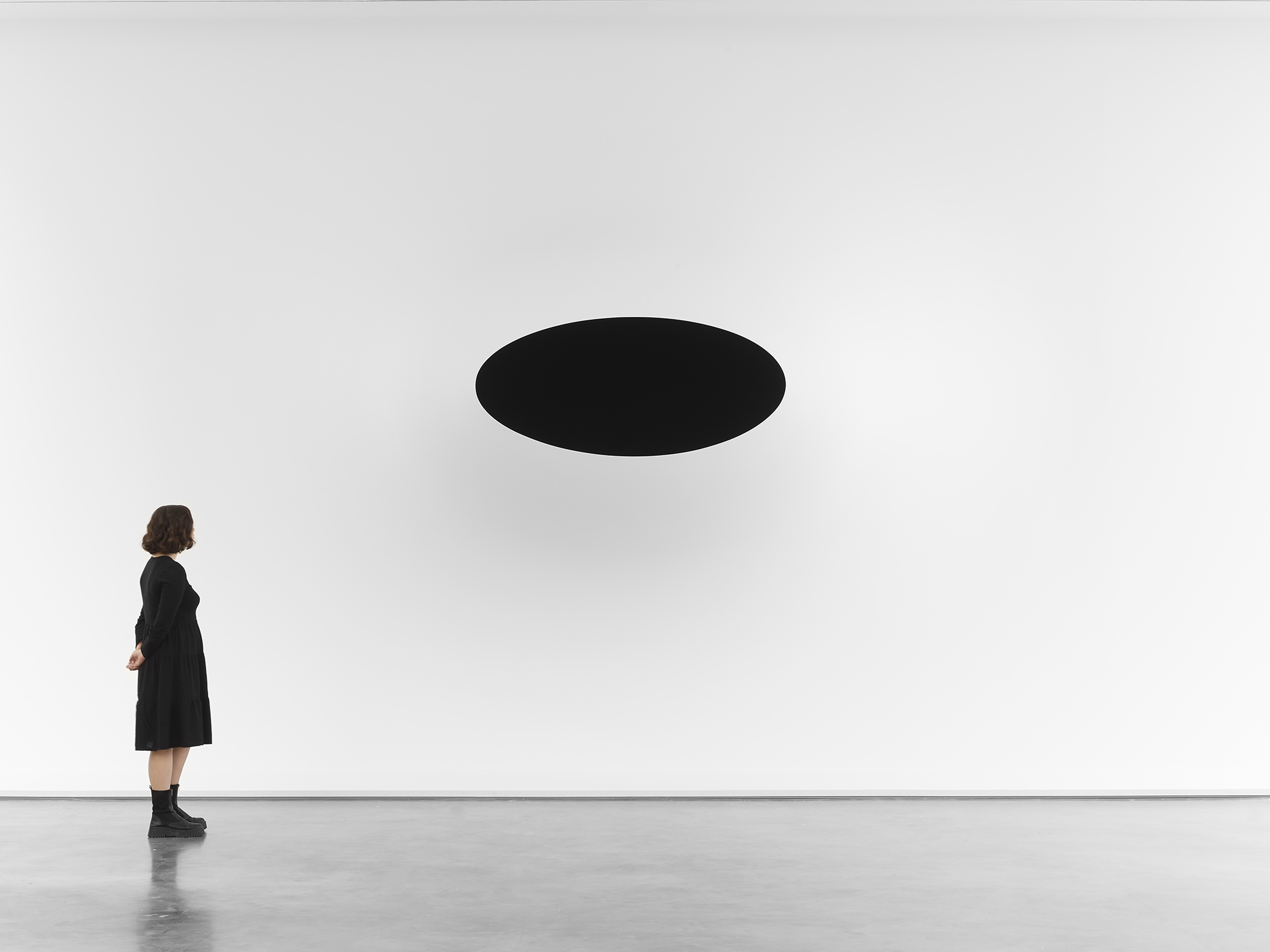On View
How he perfected the use of this high-tech material remains a mystery.
The first headlines came way back in 2014. British Indian artist Anish Kapoor was experimenting with Vantablack, a newly invented material said to be the blackest black ever made.
“This material is the blackest material in the universe. Blacker than a black hole. It absorbs 99.8 percent of all light,” Kapoor wrote in an email. (Artist Diemut Strebe actually created a blacker, 99.995 percent absorbent black with MIT scientists in 2019.)
A highly-advanced scientific discovery featuring a super dense field of carbon nano tubes grown in a lab and heated to super-high temperatures in a reactor, Vantablack was invented by the U.K. firm Surrey NanoSystems with military purposes in mind. But Kapoor believed in its artistic potential right from the get-go. So much so, that he signed a contract securing the exclusive rights to the new material’s use in painting and sculpture.
The move was immediately controversial, kicking off an art supply feud with an artist named Stuart Semple who has since dedicated himself to creating the blackest paints he can, as well as “the pinkest pink” and “the glitteriest glitter”, all available for anyone except Kapoor to use.
“Anish Kapoor,” featuring the U.S. debut of the artist’s Vantablack works, installation view at Lisson Gallery, New York. Photo courtesy of Lisson Gallery, New York.
But Kapoor has long maintained that his agreement with Surrey was a necessary step in developing artistic applications for Vantablack. (It is exceedingly delicate and complicated to produce, and could initially only be made in tiny amounts.)
“This material was made for the defense industry, so I had to gently persuade the company to work with me,” Kapoor said. “It has now been over 10 years since we started our project. This material is highly technical in its application—it is not a paint.”
It wasn’t until 2022, during the Venice Biennale, that Kapoor finally unveiled the fruits of his labor, showing his first Vantablack works at a dual-venue show at the Gallerie dell’Accademia di Venezia and Palazzo Manfrin.
“Anish Kapoor,” featuring the U.S. debut of the artist’s Vantablack works, installation view at Lisson Gallery, New York. Photo courtesy of Lisson Gallery, New York.
Now—on the heels of the release of Semple’s Black 4.0 paint, which claims to be just as light-absorbent as Vantablack—these works are making their U.S. debut, in a show at New York’s Lisson Gallery. Kapoor did not answer questions about Semple, or whether he would ever consider allowing other artists to get their hands on Vantablack now that he’s mastered it.
We tried to get Kapoor to share some details about the long period of trial and error that made his Vantablack sculptures possible, but he was frustratingly tightlipped about the process. He ignored our questions about failed experiments with the material, and about whether collectors need to ensure any special conditions to properly care for Vantablack paintings or sculptures—the prices of which have not yet been disclosed.
When asked how he applied Vantablack to his work, and if the process differs from work to work, Kapoor said only that “the reactor used takes the process to very high temperatures so the objects need to be made appropriately.”
“Anish Kapoor,” featuring the U.S. debut of the artist’s Vantablack works, installation view at Lisson Gallery, New York. Photo courtesy of Lisson Gallery, New York.
What attracted the artist to Vantablack was his fascination with the void, and his efforts to create the illusion of bottomless depth.
“In the Renaissance, there were two great discoveries: perspective and the fold. The fold is a representation of being as we know. If I put this material [Vantablack] on a fold, it would not be seen,” he wrote. “The fold becomes invisible—like Malevich, I claim that this takes the object into a four-dimensional space and time, and beyond being.”
Kapoor, of course, is perhaps best known for the beloved Chicago public sculpture Cloud Gate, popularly called “The Bean,” which has a wonderful mirrored surface that creates warped reflections of the viewer and the city, which shift as you walk around it. One could argue that you haven’t really been to a proper art fair unless you have seen one of his mirrored disk sculptures and marveled at the way your reflection flips and reverses as you approach.
“Anish Kapoor,” featuring the U.S. debut of the artist’s Vantablack works, installation view at Lisson Gallery, New York. Photo courtesy of Lisson Gallery, New York.
The artist’s dual interests in reflectivity and light absorbency, and their opposite effects in a work of art, seem to be working in opposition, as well as being two sides of the same coin. (We asked Kapoor if it was one or the other, and he simply responded “yes.”)
“The mirror works are concave and are hollow spaces full of mirror; the black works are filled with darkness,” he said. “They are opposite and equal.”
“Anish Kapoor” is on view at Lisson Gallery, 504 and 508 West 24th Street, New York, New York, November 2–December 16, 2023.
More Trending Stories:
Revealed: The Major Mystery Consignors of New York’s Multi-Billion-Dollar Fall Auction Season
Christie’s Pulled Two Works by a Prominent Middle Eastern Artist From Sale After a Complaint
Follow Artnet News on Facebook:
Want to stay ahead of the art world? Subscribe to our newsletter to get the breaking news, eye-opening interviews, and incisive critical takes that drive the conversation forward.







